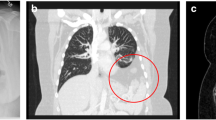Abstract
Purpose
Thoracoabdominal hernias remain a rare and poorly understood entity. Data remain sparse as terminology varies in the literature and case reports demonstrate wide variability in technique. We present a novel approach for repair of thoracoabdominal hernias using the robotic platform.
Methods
Two patients underwent a robotic thoracoabdominal hernia repair in June 2022. They were followed for 1 year with CT scans every 6 months to exclude recurrence. Patient demographics and peri-operative details including defect size, closure technique, mesh size, length of stay, and complications were reported.
Results
Both patients successfully underwent a robotic repair of a thoracoabdominal hernia, addressing the intercostal hernia, diaphragmatic disruption, and flank hernia discretely during the operation. One patient had an uneventful recovery and discharged on post-operative day 3; the other developed a small bowel obstruction due to an early port site hernia which required surgical intervention. He eventually discharged on post-operative day 9. At one year, there is no clinical or radiographic evidence of recurrence for either patient.
Conclusion
Robotic thoracoabdominal hernia repair is feasible and offers a minimally invasive repair option for these extremely complex hernias.







Similar content being viewed by others
References
Alayon-Rosario M, Schlosser K, Griscom T et al (2020) Primary thoracoabdominal hernias. Hernia. https://doi.org/10.1007/s10029-020-02194-7
Morrell DJ, DeLong CG, Horne CM, Pauli EM (2022) Radiographic identification of thoracoabdominal hernias. Hernia 26(1):287–295. https://doi.org/10.1007/s10029-021-02437-1
Gooseman MR, Rawashdeh M, Mattam K, Rao JN, Vaughan PR, Edwards JG (2019) Unifying classification for transdiaphragmatic intercostal hernia and other costal margin injuries. Eur J CardioThora Surg 56:150–158. https://doi.org/10.1093/ejcts/ezz020
Kalles V, Dasiou M, Doga G et al (2015) Posttraumatic transdiaphragmatic intercostal hernia: report of a case and review of the literature. Int Surg 100(3):444–449. https://doi.org/10.9738/INTSURG-D-13-00272.1
Aggarwal G, Khandelwal G, Shukla S, Maheshwari A, Mathur R, Acharya D (2012) Spontaneous transdiaphragmatic intercostal hernia: a rare clinical entity. Hernia 16(1):113–115. https://doi.org/10.1007/s10029-010-0717-5
Daniel R, Naidu B, Khalil-Marzouk J (2008) Cough-induced rib fracture and diaphragmatic rupture resulting in simultaneous abdominal visceral herniation into the left hemithorax and subcutaneously. Eur J Cardiothorac Surg 34:914–915
Aladaileh M, O’Driscoll-Collins A, O’Keeffe F, Conneely JB, Redmond K (2020) Traumatic thoracoabdominal hernia repair using a novel chest-wall reconstruction technique: a case report. Ann R Coll Surg Engl 102(1):e4–e6. https://doi.org/10.1308/rcsann.2019.0120
Alayon-Rosario M, Schlosser K, Griscom T, Bolton W, Hall A, Augenstein V, Cobb WS, Warren JA, Carbonell AM (2021) Primary thoracoabdominal hernias. Hernia 25(6):1621–1628. https://doi.org/10.1007/s10029-020-02194-7
Bobbio A, Ampollini L, Prinzi G, Sarli L (2008) Endoscopic repair of an abdominal intercostal hernia. Surg Laparosc Endosc Percutan Tech 18(5):523–525. https://doi.org/10.1097/SLE.0b013e31817f2883
Luqman MQ, Mughal A, Waldron R, Khan IZ (2018) Laparoscopic IPOM repair of an acquired abdominal intercostal hernia. BMJ Case Rep. https://doi.org/10.1136/bcr-2018-227158
Gokcal F, Morrison S, Kudsi OY (2019) Short-term comparison between preperitoneal and intraperitoneal onlay mesh placement in robotic ventral hernia repair. Hernia 23:957–967. https://doi.org/10.1007/s10029-019-01946-4
Seder CW, Allen MS, Nichols FC, Wigle DA, Shen KR, Deschamps C, Cassivi SD (2014) Primary and prosthetic repair of acquired chest wall hernias: a 20-year experience. Ann Thorac Surg 98(2):484–489. https://doi.org/10.1016/j.athoracsur.2014.03.021
Losanoff JE, Richman BW, Jones JW (2004) Recurrent intercostal herniation of the liver. Ann Thorac Surg 77(2):699–701. https://doi.org/10.1016/S0003-4975(03)00749-5
Author information
Authors and Affiliations
Contributions
All authors contributed to the study conception. All were involved in the operative planning and novel technique presented in this article. The first draft of the manuscript was written by Sabrina Drexel and all authors commented on multiple versions of the manuscript. All authors read and approved the final version.
Corresponding author
Ethics declarations
Conflict of interest
Sabrina Drexel: Proctor and Speaker for Intuitive Surgical, Proctor for Synapse Biomedical. Daniel Tseng and Jeffrey Watkins have nothing to declare. There was no funding for this study.
Ethical approval
Approval from the Institutional Review Board was not required for this study.
Research involving human participants and/or animals
This article does not contain any animal studies. The study is retrospective in nature and does not involve ongoing human subject studies.
Informed consent
Formal consent is not required for this retrospective review. Patients gave written consent for their operative video and CT scans to be used for academic purposes.
Additional information
Publisher's Note
Springer Nature remains neutral with regard to jurisdictional claims in published maps and institutional affiliations.
Rights and permissions
Springer Nature or its licensor (e.g. a society or other partner) holds exclusive rights to this article under a publishing agreement with the author(s) or other rightsholder(s); author self-archiving of the accepted manuscript version of this article is solely governed by the terms of such publishing agreement and applicable law.
About this article
Cite this article
Drexel, S., Watkins, J. & Tseng, D. Robotic thoracoabdominal hernia repair: a novel approach. Hernia 28, 249–254 (2024). https://doi.org/10.1007/s10029-023-02903-y
Received:
Accepted:
Published:
Issue Date:
DOI: https://doi.org/10.1007/s10029-023-02903-y




